VR fitness creates a unique bridge between mental and physical wellness, adapting to your specific mobility needs through customizable environments. You’ll experience reduced stress, anxiety, and depression while engaging in immersive workouts that feel more like play than exercise. From rehabilitation to recreation, these platforms allow you to track progress, connect with others, and overcome traditional fitness barriers—all from home. Discover how this technology transforms therapy into an engaging journey that benefits both mind and body.
Breaking Barriers: How VR Transforms Exercise for Diverse Abilities
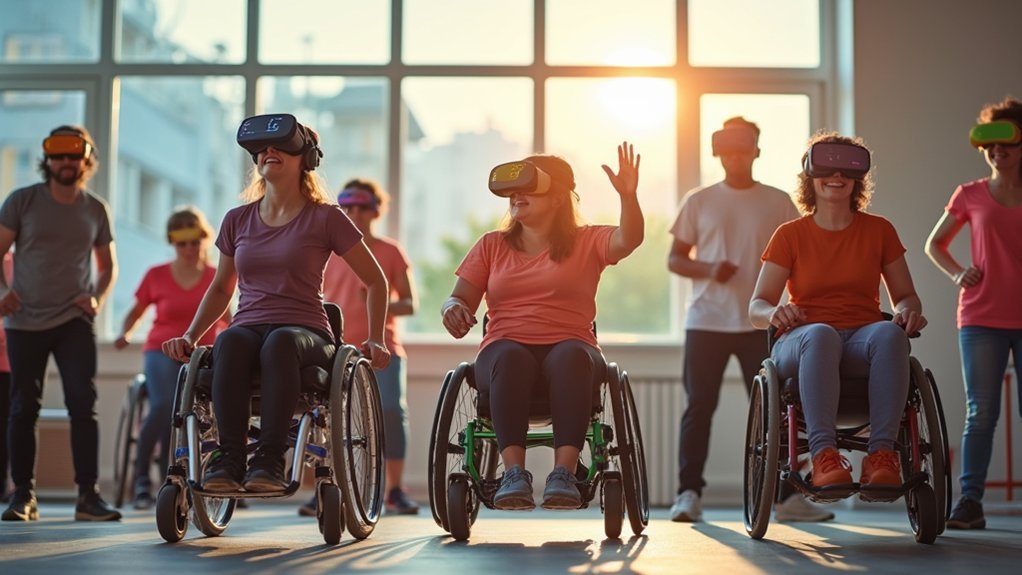
While traditional fitness programs often exclude those with limited mobility, VR technology is breaking down these barriers with remarkable results.
You’ll find these systems can be tailored to recognize even subtle movements like head tilts or finger gestures, allowing you to participate fully regardless of physical limitations.
Virtual environments adjust to accommodate your visual and auditory sensitivities, ensuring comfort throughout your workout.
The beauty of VR lies in its equality—you can compete in virtual races and activities alongside others, fostering genuine social integration and community.
Research consistently shows that home workouts using VR can be just as effective as traditional gym-based exercise programs.
The Mind-Body Connection: VR’s Dual Impact on Mental and Physical Health
The revolutionary accessibility of VR fitness reveals a profound truth about human wellness—our minds and bodies are inseparable partners in health.
VR fitness erases the false divide between mental and physical wellness, showing us the truth about holistic health.
When you exercise in virtual reality, you’re not just building muscle strength—you’re simultaneously reducing stress and enhancing cognitive function.
- Each VR session can transform tension into calm while improving your balance and coordination.
- Your mood elevates as your physical capabilities expand, creating a positive feedback loop.
- Immersive environments increase your exercise enjoyment, making you more likely to maintain consistent activity.
- Social VR fitness options combat isolation while building strength, addressing emotional and physical needs simultaneously.
- Customized VR programs adapt to your unique abilities, supporting both psychological confidence and physical rehabilitation.
Games like AudioShield Modded and Thrill of the Fight can help you burn calories quickly while providing an engaging gaming experience.
Adaptive Movement in Virtual Worlds: Customizing Fitness for All Bodies
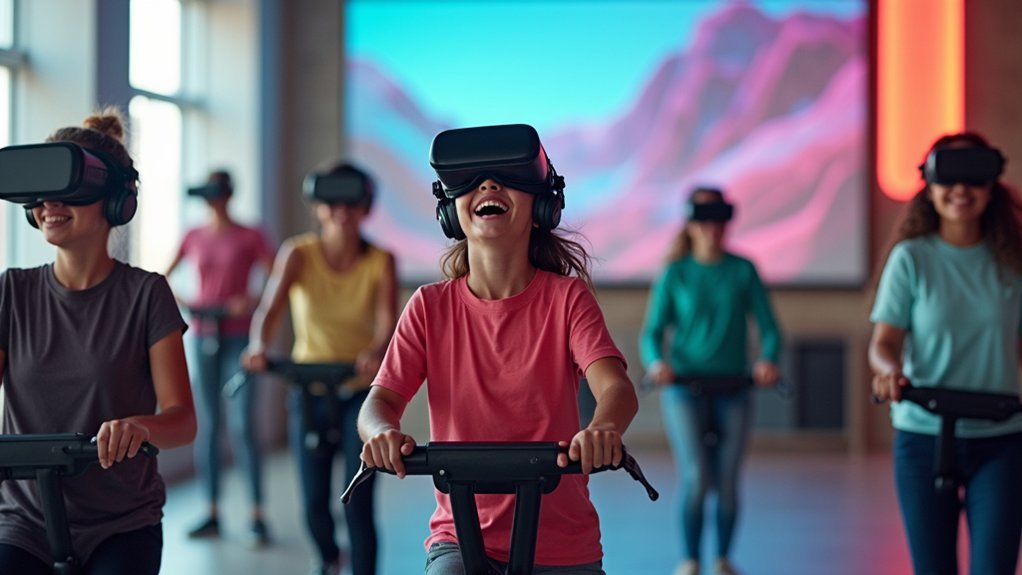
You’ll find VR fitness technologies adapting to your unique physical needs through customizable environments that adjust to various mobility levels, sensory preferences, and exercise capabilities.
Your rehabilitation journey transforms when digital systems analyze your movements in real-time, offering personalized feedback and gradually increasing challenges as your abilities improve.
Combat sports like VR boxing demonstrate higher energy expenditure compared to other virtual activities, making them particularly effective for individuals with neurodevelopmental and neurodegenerative disorders seeking physical improvement.
These adaptive VR platforms create equal opportunities for fitness participation, regardless of physical limitations, by tailoring experiences that respond specifically to your body’s capabilities and rehabilitation goals.
Accessibility Through Adaptation
Virtual reality fitness revolutionizes accessibility by adapting to diverse bodies and abilities rather than forcing users to conform to rigid exercise standards.
You’re empowered through systems that recognize your unique movement capabilities—whether you’re using subtle finger motions or full-body actions.
- Personalized calibration accommodates your specific mobility range, making fitness achievable regardless of physical limitations.
- Adaptive tracking differentiates intentional gestures even when traditional movements aren’t possible.
- Sensory customization reduces overwhelming stimuli for neurodiverse users, adjusting visuals and audio to your comfort level.
- Competitive balance allows wheelchair users to participate alongside able-bodied peers in fair, engaging competitions.
- Continuous feedback loops encourage gradual improvement, keeping you motivated as you progress at your own pace.
This inclusivity fosters both physical benefits and psychological well-being, creating spaces where everyone belongs. Research shows that virtual reality technology addresses major accessibility barriers for disabled individuals by eliminating transportation challenges to physical training facilities.
Personalized Digital Rehabilitation
Personalized digital rehabilitation represents the next frontier in VR fitness, transforming traditional therapy into dynamic, adaptive experiences. Your recovery journey can now be tailored to your unique needs, with real-time adjustments to difficulty levels that prevent frustration while maintaining therapeutic challenge.
You’ll benefit from immersive environments that adapt as you progress, providing immediate feedback that accelerates recovery. This personalization isn’t just convenient—it’s clinically effective. Studies show the market for these technologies reached $336.90 million in 2021 and is projected to exceed $1.1 billion by 2027.
The advantages are clear: you’ll experience improved motivation, enhanced psychological outcomes, and measurable progress. Virtual rehabilitation platforms now incorporate specialized Exergame exercises to support patients with cognitive rehabilitation for conditions including Parkinson’s disease, cerebral palsy, and anxiety disorders.
Pain management becomes more effective as you engage with exercises that automatically adjust to your capabilities, ensuring ideal rehabilitation without overexertion.
Beyond Physical Limitations: Finding Freedom in Virtual Reality Workouts
For individuals with mobility challenges, physical limitations, or chronic health conditions, traditional fitness routines often present frustrating barriers rather than opportunities for growth.
VR fitness transforms these limitations into possibilities, offering you freedom to move in ways physical reality might restrict.
Break free from physical constraints as virtual reality reimagines what movement can mean for your uniquely capable body.
- Adaptive exercises modify movements to accommodate your specific needs and abilities
- Real-time feedback guarantees you’re maintaining proper form to prevent further injury
- Home-based accessibility eliminates transportation barriers and gym anxiety
- Continuous participation allows you to maintain fitness during recovery phases
- Immersive environments distract from discomfort, making rehabilitation more enjoyable
You’ll discover newfound independence as VR technology creates a safe space where your body’s limitations don’t define your fitness journey. The cognitive engagement provided by VR workouts simultaneously enhances mental health while improving coordination and reaction time.
The virtual world becomes your playground for exploration and healing.
The Therapeutic Power of Immersive Exercise for Mental Wellbeing
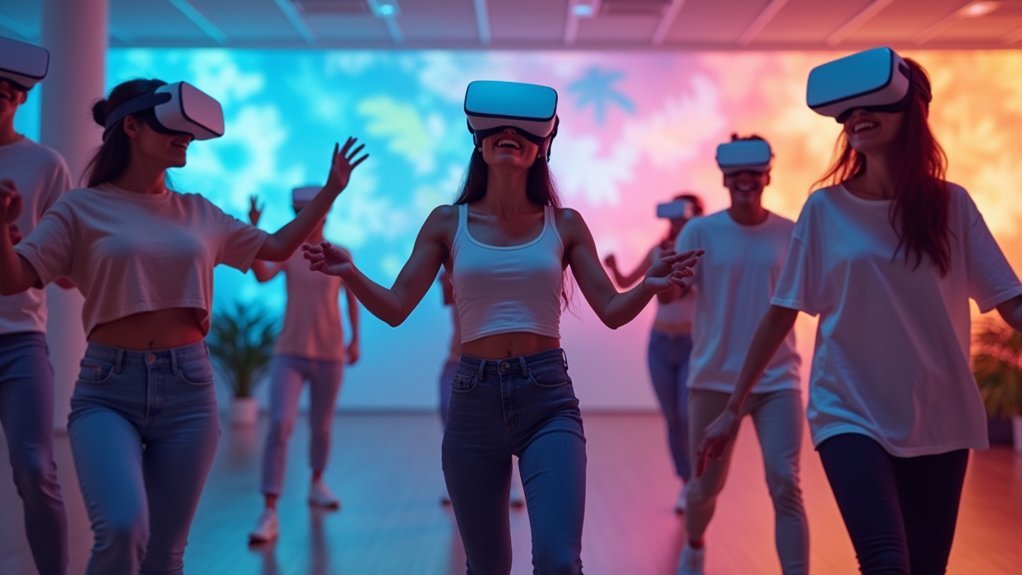
Your virtual reality workout offers more than physical benefits—it creates a powerful mind-body connection that can transform your mental health.
You’ll experience reduced anxiety and depression as your brain becomes fully engaged in the immersive environment, allowing you to escape mental stressors while your body moves.
The combination of movement therapy with VR’s psychological ownership effect creates a unique therapeutic experience that traditional exercise simply can’t match. Studies show that when participants watched an avatar running for 30 minutes, they experienced a reduction in salivary alpha-amylase, a key stress biomarker.
Mind-Body Immersion Benefits
While traditional exercise has always offered physical benefits, the emerging field of VR fitness delivers a powerful combination of mental and physical therapy through immersive experiences.
You’ll find your perception of exertion considerably reduced while in virtual environments, making workouts feel less strenuous than they actually are. This mind-body connection creates a unique therapeutic opportunity that extends beyond conventional exercise. Research demonstrates that participants report higher enjoyment levels across all enjoyment subscales compared to traditional screen-based exercise.
- Immersive environments reduce perceived exertion while maintaining or increasing actual energy expenditure
- Real-time feedback systems create personalized motivation loops, enhancing your performance
- Integration of visual and auditory elements creates a holistic sensory experience
- Customizable workouts adapt to your specific needs and limitations
- VR’s distracting qualities can diminish pain perception, making exercise more accessible for rehabilitation
Stress-Relief Through Movement
As the world grows increasingly stressful, VR fitness emerges as a powerful antidote for mental health challenges by combining therapeutic movement with immersive distraction.
You’ll find yourself exercising longer while perceiving less exertion—a psychological trick that boosts adherence and results.
Research confirms VR workouts reduce anxiety and depression more effectively than traditional exercise. The immersive environments shift your focus away from physical discomfort and mental stress, allowing you to work harder while feeling less strain.
This mind-body connection isn’t just theoretical—participants consistently report improved mood, increased happiness, and decreased stress levels after VR fitness sessions. A recent study demonstrated significant improvements in positive affect immediately following VR exercise sessions compared to screen-based alternatives.
The customizable nature of virtual workouts means you can select environments and activities tailored to your specific mental health needs, making therapeutic movement accessible regardless of your fitness level.
Building Community Through Accessible VR Fitness Platforms
Once considered a solitary activity, fitness has transformed into a communal experience through the emergence of accessible VR platforms.
You’ll find that nearly half of VR users exercise more frequently than before, particularly those with mobility challenges who can now participate in ways previously impossible. Studies show that 43% of users report improved mental health due to their VR fitness routines.
- Connect with workout partners in immersive environments like neon-lit boxing rings
- Participate in virtual events that foster belonging regardless of physical location
- Earn rewards through gamified challenges that keep you consistently engaged
- Track your progress alongside a supportive community celebrating your milestones
- Access personalized workouts created by AI algorithms analyzing your unique data
This democratization of fitness breaks down traditional barriers, creating inclusive spaces where you’ll find motivation through shared experiences and technological innovation—making exercise both physically rewarding and socially fulfilling.
From Rehabilitation to Recreation: The Evolution of Adaptive VR Exercise
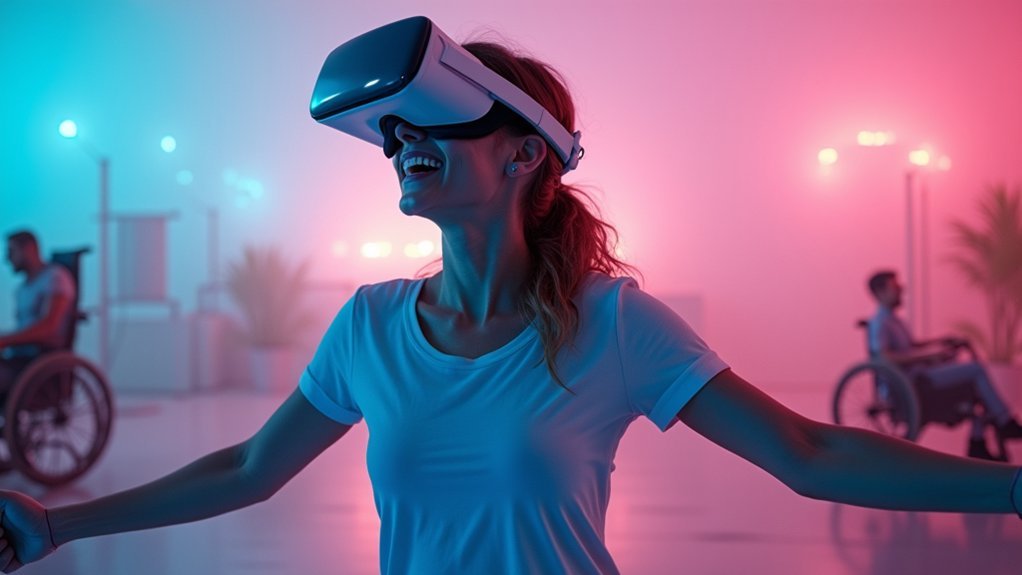
Virtual reality’s journey from clinical rehabilitation tool to recreational fitness platform represents one of healthcare technology’s most remarkable transformations.
You’ll find that today’s VR systems blend therapeutic benefits with engaging gameplay, creating a seamless bridge between recovery and recreation.
What began as structured 45-minute rehabilitation sessions for conditions like Parkinson’s Disease has evolved into customizable exercise programs you can safely use at home.
These adaptive systems track your movements precisely, adjusting intensity levels to match your specific needs while monitoring fatigue.
VR fitness platforms intelligently adapt to your body’s capabilities, fine-tuning challenges while watching for signs of overexertion.
Combat sports and other immersive activities not only improve upper limb movement but also provide stress relief and social interaction opportunities.
The technology’s growing accessibility and cost-effectiveness make it an attractive alternative to traditional therapy, offering you extensive physical and mental health benefits through a multidisciplinary approach that keeps you motivated and engaged.
Research shows this approach is particularly valuable for post-COVID patients, with 75% reporting VR positively influenced their recovery process during home-based rehabilitation programs.
Frequently Asked Questions
How Much Does VR Fitness Equipment Cost Compared to Traditional Gym Memberships?
VR fitness equipment costs $1,199-$4,999 upfront versus $20-$50 monthly gym memberships. While you’ll pay more initially for VR, you’ll potentially save money long-term by eliminating recurring membership fees.
Can VR Fitness Cause Motion Sickness, and How Can It Be Prevented?
Yes, VR fitness can cause motion sickness in 50-80% of users. You’ll prevent it by choosing high refresh rate headsets, taking regular breaks, starting with gentle content, and gradually building your VR tolerance over time.
What Are the Space Requirements for Effective VR Fitness at Home?
You’ll need at least 2m x 1.5m for effective home VR fitness. Confirm your space has smooth flooring, good lighting, and is free of obstacles. Remember to maintain clearance for full movement during workouts.
Are There Age Restrictions for Participating in VR Fitness Programs?
Yes, you’ll find most VR fitness programs restrict users under 13 years old, following headset manufacturer guidelines. Teens can participate with parental supervision, while younger children should only use age-appropriate, monitored content for safety reasons.
How Do VR Fitness Metrics Compare to Health Tracking Wearable Devices?
VR fitness metrics provide comparable calorie tracking to wearables, but excel in motion capture detail. You’ll find they’re similar for basic activities, while complex VR movements may be tracked more accurately than with traditional devices.
In Summary
You’re witnessing a revolution in accessible fitness. VR doesn’t just transform your workout—it breaks down barriers that once limited who could exercise and how. As you step into these virtual worlds, you’re finding both physical challenge and mental healing. Whether you’re seeking rehabilitation or community, VR fitness isn’t just changing games—it’s changing lives by meeting you exactly where you are.

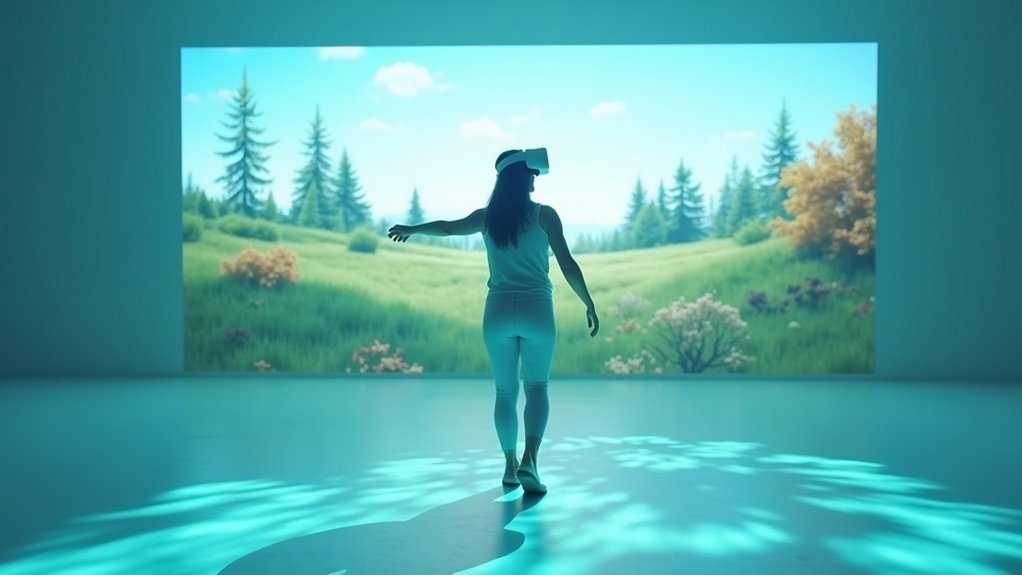



Leave a Reply